

Added 18 December 2008
Monday, 10 November 2008, Moqui Canyon, Lake Powell, Utah
(Hover over images for captions. Click images for larger versions.)
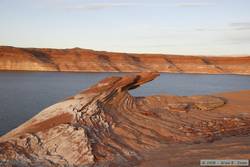
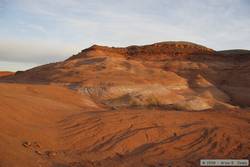 I had picked my sleeping spot hoping that the earliest morning light would wake me up to take some more pictures. I was up before the sun, but barely. Unfortunately, I miscalculated the sun, which rose further south than I had anticipated. As a result, I couldn't get my long shadow out of the photos I had scouted out the night before. I soon gave up and just decided to pack up and get ready to paddle to our next camp site in Moqui Canyon.
I had picked my sleeping spot hoping that the earliest morning light would wake me up to take some more pictures. I was up before the sun, but barely. Unfortunately, I miscalculated the sun, which rose further south than I had anticipated. As a result, I couldn't get my long shadow out of the photos I had scouted out the night before. I soon gave up and just decided to pack up and get ready to paddle to our next camp site in Moqui Canyon.

|

|
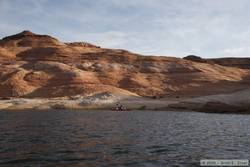
|
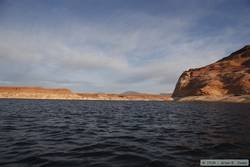
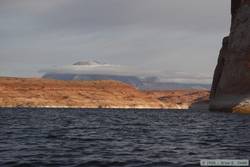
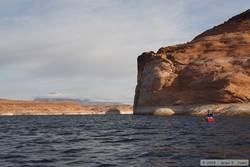 Chuck, Mindy and I all seemed to be ready at about the same time so we launched and paddled from shore a ways just to enjoy the beautiful light from the water. Once away from shore we could see the Henry Mountains, which had a neat layer of clouds that ringed the mountain but left the peaks standing up above them.
Chuck, Mindy and I all seemed to be ready at about the same time so we launched and paddled from shore a ways just to enjoy the beautiful light from the water. Once away from shore we could see the Henry Mountains, which had a neat layer of clouds that ringed the mountain but left the peaks standing up above them.
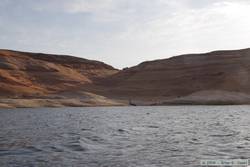
|
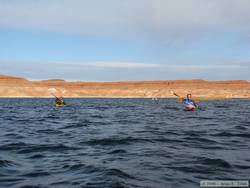
|
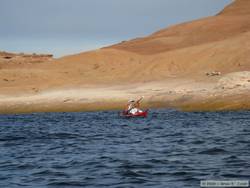
|
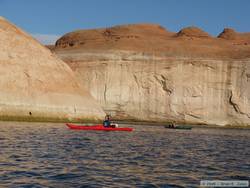
|

|

|
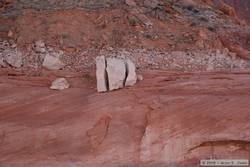
 The overnight breeze had turned into something approaching a wind so once we got away from the protected shoreline, we were fighting waves that occasionally became white-capped. I had a couple of waves come over the side and land in my lap, as I hadn't bothered wearing my spray skirt. The wave bounce from the canyon walls made for a rather confusing sea, but everyone seemed to be handling it pretty well. Still, we were all glad to reach Moqui Canyon, which didn't necessarily stop our fight against the wind, but it did mean calmer waters.
The overnight breeze had turned into something approaching a wind so once we got away from the protected shoreline, we were fighting waves that occasionally became white-capped. I had a couple of waves come over the side and land in my lap, as I hadn't bothered wearing my spray skirt. The wave bounce from the canyon walls made for a rather confusing sea, but everyone seemed to be handling it pretty well. Still, we were all glad to reach Moqui Canyon, which didn't necessarily stop our fight against the wind, but it did mean calmer waters.
Moqui Canyon felt more quintessentially Glen Canyon (or perhaps more quintessentially Lake Powell, which isn't necessarily the same thing) than Forgotten or Smith Fork Canyons. Those canyons were certainly awe-inspiring, but at Moqui I really felt like we had arrived. I suspect I would feel differently in July with tons of yahoos zipping around on jetskis and speedboats, as I'm sure it's a very popular canyon, being so close to Hall's Crossing and Bullfrog Marinas.
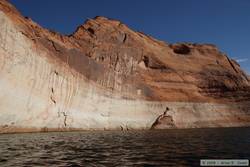
|
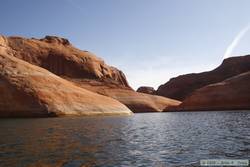
|

|
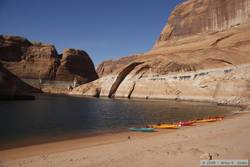

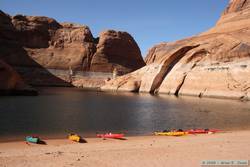 We had hoped to find a place to camp somewhere near the mouth of Moqui Canyon so we'd have a really short paddle on our next and final day, but we ended up having to go back 3.2 miles before we found a site that could accommodate us. It was a great site except for two things, it wasn't sheltered from the wind that was blowing, and a bunch of idiots had been using part of it as a latrine instead of following the rule of using portable toilets or other "pack it out" methods. There was at least enough room to avoid those areas though.
We had hoped to find a place to camp somewhere near the mouth of Moqui Canyon so we'd have a really short paddle on our next and final day, but we ended up having to go back 3.2 miles before we found a site that could accommodate us. It was a great site except for two things, it wasn't sheltered from the wind that was blowing, and a bunch of idiots had been using part of it as a latrine instead of following the rule of using portable toilets or other "pack it out" methods. There was at least enough room to avoid those areas though.
 Due to the wind, and the greater likelihood of critter camp raiders due to the uncleanliness of previous users, I decided to set my tent up for the first time on the trip.
Due to the wind, and the greater likelihood of critter camp raiders due to the uncleanliness of previous users, I decided to set my tent up for the first time on the trip.  When everyone had set their camp up, it was still about an hour early for lunch, but we decided to go ahead and eat lunch before hoping back in our kayaks to continue on in to Moqui Canyon to hike up to the several ruins there.
When everyone had set their camp up, it was still about an hour early for lunch, but we decided to go ahead and eat lunch before hoping back in our kayaks to continue on in to Moqui Canyon to hike up to the several ruins there.
We didn't have to paddle far before reaching the end of the lake but what we found there was a lot of sticky, nasty mud, and it took a little doing to get everyone on dry land without getting all muddy. I ended up getting out of my kayak onto a log while Chuck steadied my boat, then I used driftwood on shore to create a makeshift boat ramp/dock so that everyone would have some solid footing to get out of their kayaks onto. Chuck found his own spot to beach though.
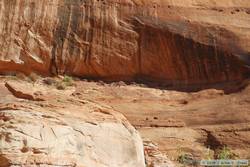
 With everyone ashore, we started hiking up the canyon. In Moqui, more than any other canyon we visited, the process of lake sedimentation and erosion was evident. We hiked between 30+ foot vertical walls of sediment that had been deposited during high water and were now being eroded through during lower water.
With everyone ashore, we started hiking up the canyon. In Moqui, more than any other canyon we visited, the process of lake sedimentation and erosion was evident. We hiked between 30+ foot vertical walls of sediment that had been deposited during high water and were now being eroded through during lower water.
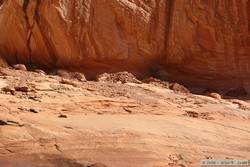
|

|
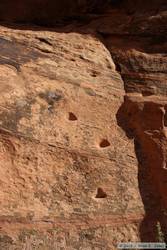
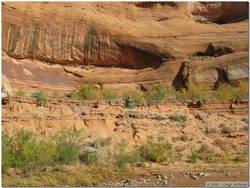
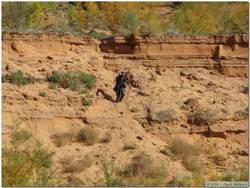 When we got to the first cliff dwelling, we were still in the sediment canyon, but I found a route out through a side cut. I hiked to the base of the cliff and found the chiseled toe and hand trail carved into the cliff. I really wanted to get up to the ruins, but the carved holds were much smaller than I would have expected, and were beyond my bravery level to try, at least in sandals. So I stood there looking longingly upward, admiring the Hisatsinom for their bravery.
When we got to the first cliff dwelling, we were still in the sediment canyon, but I found a route out through a side cut. I hiked to the base of the cliff and found the chiseled toe and hand trail carved into the cliff. I really wanted to get up to the ruins, but the carved holds were much smaller than I would have expected, and were beyond my bravery level to try, at least in sandals. So I stood there looking longingly upward, admiring the Hisatsinom for their bravery.
I did some sand cliff skiing to reunite with the group and we continued on up the canyon. Moqui Creek and the canyon it ran through were gorgeous, making for a thoroughly enjoyable hike. Eventually we came across a cattle track, then more, then more, along with cow dung all over the stream. It felt like someone had turned a herd of cows loose in the Sistine Chapel. Highly upsetting. The sand slides that supposedly offer hiking access to the otherwise impenetrable canyon were very impressive and it was neat to see the various wild animal tracks on it. Presumably that's how the cows get there as well.
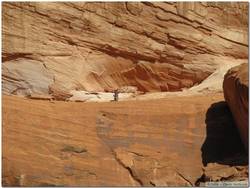
|
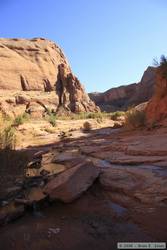
|
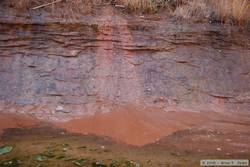
|

|
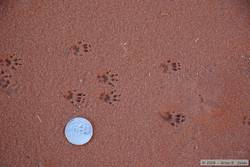
|

|
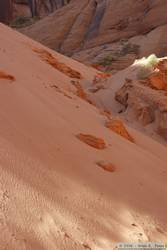
|

|
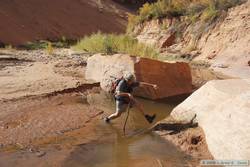
|
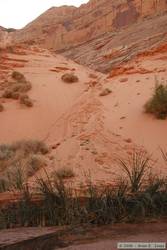
|
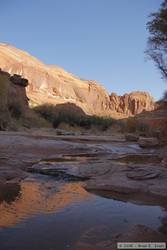
|
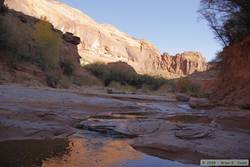
|
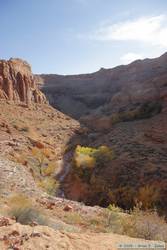 After hiking a couple of miles we reached the next, and supposedly best cliff dwelling in Moqui Canyon. These ruins were much higher up, but the approach seemed more doable and I was determined to reach them. Mindy was the only one who decided to make the attempt with me, but she didn't feel comfortable at one tricky part and turned around.
After hiking a couple of miles we reached the next, and supposedly best cliff dwelling in Moqui Canyon. These ruins were much higher up, but the approach seemed more doable and I was determined to reach them. Mindy was the only one who decided to make the attempt with me, but she didn't feel comfortable at one tricky part and turned around.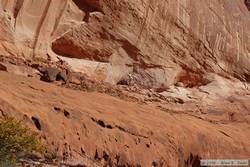 It's too bad she wasn't able to make it past that spot, because it may have been the hardest part. It took a fair amount of searching to find the route, but there was one small break in a low cliff that gave me access to the slope just below the cliff dwellings.
It's too bad she wasn't able to make it past that spot, because it may have been the hardest part. It took a fair amount of searching to find the route, but there was one small break in a low cliff that gave me access to the slope just below the cliff dwellings.
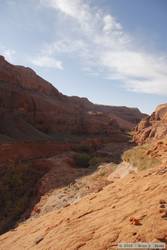 The slope was largely talus and was unstable enough to give me pause as I continued higher. The "Glen Canyon awe and fear effect" started to take hold, but I maintained my determination and pressed on, albeit always with an eye on how much exposure there was should I fall or should the slope fail. I also took my pack off to increase my mobility and balance, carrying only my camera onward.
The slope was largely talus and was unstable enough to give me pause as I continued higher. The "Glen Canyon awe and fear effect" started to take hold, but I maintained my determination and pressed on, albeit always with an eye on how much exposure there was should I fall or should the slope fail. I also took my pack off to increase my mobility and balance, carrying only my camera onward. 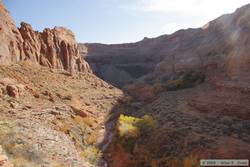 After trying a few routes too loose to traverse, I found a way to get to the first building, which lead easily to the rest. One thing is certain, the Hisatsinom could not have been acrophobic. The thought of living there was rather frightening. One certainly couldn't complain about the view though. The cliff dwelling commanded views up and down the canyon that were truly amazing. Once again, if I didn't have friends waiting for my return, I could easily have stayed there enjoying the world for hours.
After trying a few routes too loose to traverse, I found a way to get to the first building, which lead easily to the rest. One thing is certain, the Hisatsinom could not have been acrophobic. The thought of living there was rather frightening. One certainly couldn't complain about the view though. The cliff dwelling commanded views up and down the canyon that were truly amazing. Once again, if I didn't have friends waiting for my return, I could easily have stayed there enjoying the world for hours.

|
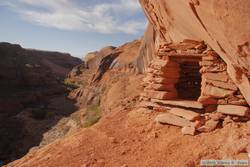
|
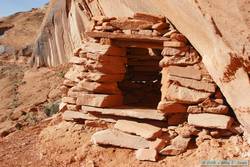
|
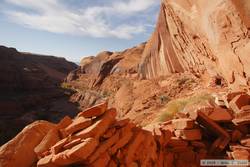
|

|

|
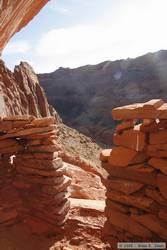
|

|
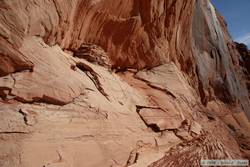
|

|
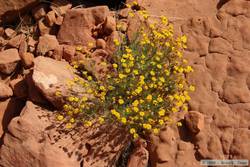
|
Alas, I had to navigate my way back down, knowing that often descending is worse than going up. For the most part, it was easier, but there were a few places where I had to rely on the root systems of some bunch grass to safely descend. Fortunately all the plants were held stoutly in place. Once I got to where Mindy turned around, I tried to mirror her route, which was better than the way we came up, but somewhere along the line I missed a turn and ended up 2/3 of the way down a steep, loose ravine staring down a 10 foot dryfall with a narrow ledge about half-way down it. Chuck came over to help, and I threw my pack and camera down to him to make the descent easier. At Chuck's suggestion, I belly slid over the edge of the waterfall, using the few solid items there were above the fall to anchor my descent. Before reaching the ledge I ran out of solid holds, and just had to let go and trust I could stay on the ledge when I hit it. Once safely on the ledge, I just jumped down the next section.
On the hike back we met an interesting couple who had arrived in a power boat with some friends. We chatted for a while before continuing on back to the kayaks. I got the impression that they thought we were scientists studying the canyon, and I'm not sure why.
There were two boats beached when we got back to our kayaks, both with the group of the couple we met. They were very friendly and we exchanged small talk. After helping my group launch I carefully got in and worked my way off the mud bank. By the time I got moving the group was some distance away so I paddled out strong to catch up, prompting one of the onlookers on the boats to comment that you could put a skier behind me. If you did, it would have been one BORED skier!
On the way back to camp I noticed that Mindy paused to look up North Gulch. I think she wanted to explore it, but she kept on paddling. I did the same thing, thinking that 5 days is not nearly enough time to explore even this small fraction of Glen Canyon
Back at camp, it was a drinking night and I polished off my meager remainder of margaritas, sans minestrone soup this time. Chuck drank his way into to a state of little pain and towards the end of the evening he was roaming the beach ripping out tumbleweeds to burn in the fire, an invasive species eradication program that we all encouraged. 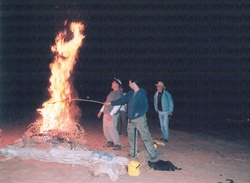 Those things go up like a roman candle so I did my part to keep Chuck's eyebrows on his face by keeping the tumbleweeds on the fire with a stick so he could pull his hands away and back off a bit. He didn't always back away as much as I would have liked, but he came away largely unscathed. Still, I feared he might stumble into the fire and was always ready to tackle him to divert him from the fire if I had to. It was fun to watch him though. Every time a tumbleweed lit up he got a look on his face that was a mix of mad scientist and kid-in-the-candy-store. By the time he stopped, he had cleared most of the tumbleweeds off the beach, and god only knows how much of it was stuck in his hands. When we left the next day, we both thought of continuing the invasive species eradication program by torching the entire beach to get rid of the rest of the tumbleweeds and the tamarisk, but decided against it.
Those things go up like a roman candle so I did my part to keep Chuck's eyebrows on his face by keeping the tumbleweeds on the fire with a stick so he could pull his hands away and back off a bit. He didn't always back away as much as I would have liked, but he came away largely unscathed. Still, I feared he might stumble into the fire and was always ready to tackle him to divert him from the fire if I had to. It was fun to watch him though. Every time a tumbleweed lit up he got a look on his face that was a mix of mad scientist and kid-in-the-candy-store. By the time he stopped, he had cleared most of the tumbleweeds off the beach, and god only knows how much of it was stuck in his hands. When we left the next day, we both thought of continuing the invasive species eradication program by torching the entire beach to get rid of the rest of the tumbleweeds and the tamarisk, but decided against it.
Everyone impressed me by staying up later than usual on the last night. It was about 10:30 p.m. before people hit the sack. All evening long I'd been thinking that I had blown my best chance for a night paddle because the clouds occluded the nearly full moon. Well, just before everyone started turning in, the sky cleared and moonlight filled the canyon. It was now or never. I announced my intentions but the only one interested in joining me was Mindy, who didn't think it would be wise to go kayaking given that she was still a little buzzed. Undeterred, I prepped my kayak for a night journey.
I didn't go very far, though. I paddled just a little over half a mile from camp, but I stayed out for over an hour. I headed down Moqui Canyon and then paddled up a short side canyon to an alcove. At the current lake level, numerous large cottonwood tree skeletons pierced the surface of the lake, looking for all the world like ghosts in the moonlight. 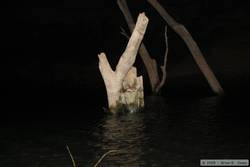 And they haunted me. More than ever I felt like I was trespassing on the hallowed ground of a battlefield graveyard. What remained of the canyon's former self was enough to allow my mind to imagine what this tiny little canyon might have looked like before the lake, and I almost cried. Thinking not only of this canyon, but the countless others like it, was painful. Drifting amongst the bleached ghosts created a greater sense of loss for a piece of earth destroyed than I had ever experienced before. That even the graveyard was beautiful mattered little.
And they haunted me. More than ever I felt like I was trespassing on the hallowed ground of a battlefield graveyard. What remained of the canyon's former self was enough to allow my mind to imagine what this tiny little canyon might have looked like before the lake, and I almost cried. Thinking not only of this canyon, but the countless others like it, was painful. Drifting amongst the bleached ghosts created a greater sense of loss for a piece of earth destroyed than I had ever experienced before. That even the graveyard was beautiful mattered little.
 Strangely however, that little canyon was the only place where I heard any kind of animal activity at night. There were animals and bugs everywhere we'd been, I'm sure, but they were almost entirely unseen and unheard. Here, crickets chirped and, I think, a frog or two as well. Everyplace else we had been was completely silent.
Strangely however, that little canyon was the only place where I heard any kind of animal activity at night. There were animals and bugs everywhere we'd been, I'm sure, but they were almost entirely unseen and unheard. Here, crickets chirped and, I think, a frog or two as well. Everyplace else we had been was completely silent. 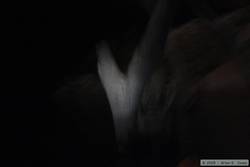 Of all the places we'd been, why did they sing only here? Perhaps they were sad too. Or happy too. I like to think that we shared those emotions together, sad to think of what it must have been, but happy to have been there at all.
Of all the places we'd been, why did they sing only here? Perhaps they were sad too. Or happy too. I like to think that we shared those emotions together, sad to think of what it must have been, but happy to have been there at all.
Eventually I decided that sleep would probably be a good thing to get a little bit of, and I slowly paddled back to camp, returning sometime after midnight, totally bewitched. It turned out to be a beautiful night and I didn't need the tent I had set up, but I slept in it anyway just so I didn't waste the effort of setting it up.
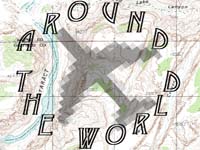 |
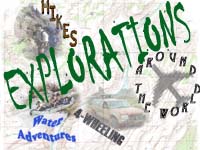 |